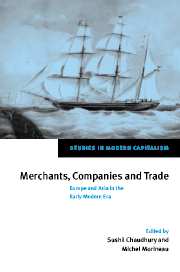Book contents
- Frontmatter
- Contents
- List of contributors
- Preface
- Introduction
- Part I Asia, especially India, around 1500
- Part II Routes, markets and merchants
- Part III European presence in Asia
- Part IV Implications of trade: Asia and Europe
- 13 The Indian challenge: seventeenth and eighteenth centuries
- 14 The changing pattern of British trade in Indian textiles,1701–1757
- 15 French traders and India at the end of the eighteenth century
- 16 The Asian merchants and companies in Bengal's export trade, circa mid-eighteenth century
- Index
14 - The changing pattern of British trade in Indian textiles,1701–1757
Published online by Cambridge University Press: 02 December 2009
- Frontmatter
- Contents
- List of contributors
- Preface
- Introduction
- Part I Asia, especially India, around 1500
- Part II Routes, markets and merchants
- Part III European presence in Asia
- Part IV Implications of trade: Asia and Europe
- 13 The Indian challenge: seventeenth and eighteenth centuries
- 14 The changing pattern of British trade in Indian textiles,1701–1757
- 15 French traders and India at the end of the eighteenth century
- 16 The Asian merchants and companies in Bengal's export trade, circa mid-eighteenth century
- Index
Summary
The legislation which prohibited the import of printed Indian textiles in Great Britain gave rise to a fundamental change in the pattern of British trade in Indian textiles. Printed piece-goods, which were mostly produced in the Madras and Bombay Presidencies, could only be procured for the re-export trade, but white cotton cloth, which was in great demand due to the rapid development of a textile printing industry around London, had to be imported in great quantities. Bengal was known for its fine white cotton cloth and this province, which had earlier played only a minor role in British–Indian trade, suddenly emerged as the main area of investment. Around 1720 the total imports from the Madras and Bombay Presidencies were still greater than those from Bengal, but within less than a decade imports from those Presidencies had receded dramatically whereas those from Bengal had doubled. During the subsequent three decades imports from Bengal generally had a value (about £400,000 per year) which was nearly thrice that of the total from the Bombay and Madras Presidencies (about £150,000 per year). In this period the value of the re-export of cotton textiles from Great Britain amounted to nearly £500,000 per year, i.e. the re-export covered the cost of imports while the expanding home market was, so to speak, getting a free ride. This indicates that the textile trade and the cotton printing industry must have been very profitable.
- Type
- Chapter
- Information
- Merchants, Companies and TradeEurope and Asia in the Early Modern Era, pp. 276 - 286Publisher: Cambridge University PressPrint publication year: 1999
- 2
- Cited by



